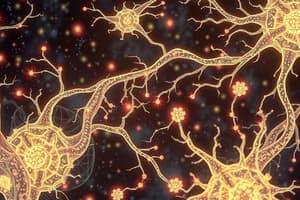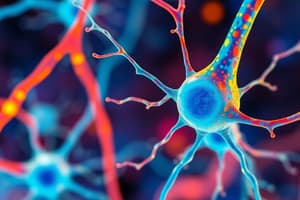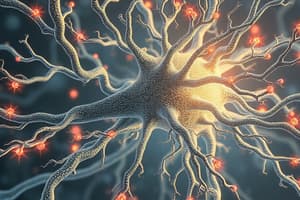Podcast
Questions and Answers
What type of neuron carries messages toward the central nervous system?
What type of neuron carries messages toward the central nervous system?
- Efferent Neurons
- Interneurons
- Motor Neurons
- Sensory Neurons (correct)
Which ion channel is primarily responsible for allowing the influx of Na+ ions during depolarization?
Which ion channel is primarily responsible for allowing the influx of Na+ ions during depolarization?
- Voltage-gated Na+ channels (correct)
- Voltage-gated K+ channels
- Ligand-gated Na+ channels
- Voltage-gated Ca2+ channels
What maintains the resting membrane potential of $−70mV$?
What maintains the resting membrane potential of $−70mV$?
- Calcium influx through voltage-gated channels
- Active transport of K+ only
- Sodium-Potassium Pump and selective permeability (correct)
- Passive diffusion of Na+
What occurs during the repolarization phase of an action potential?
What occurs during the repolarization phase of an action potential?
What limits the generation of another action potential during the refractory period?
What limits the generation of another action potential during the refractory period?
Which hormone is primarily responsible for increasing blood glucose levels?
Which hormone is primarily responsible for increasing blood glucose levels?
How does myelination affect the speed of nerve impulse transmission?
How does myelination affect the speed of nerve impulse transmission?
What is the primary function of aldosterone?
What is the primary function of aldosterone?
What triggers the exocytosis of neurotransmitters at the axon terminal?
What triggers the exocytosis of neurotransmitters at the axon terminal?
What is the function of interneurons in the nervous system?
What is the function of interneurons in the nervous system?
Which part of the body secretes erythropoietin (EPO)?
Which part of the body secretes erythropoietin (EPO)?
What role does cortisol play in the body?
What role does cortisol play in the body?
What is the main effect of noradrenaline in the body?
What is the main effect of noradrenaline in the body?
Which gland secretes hormones to maintain pregnancy and develop the fetus?
Which gland secretes hormones to maintain pregnancy and develop the fetus?
How do the nervous and endocrine systems maintain homeostasis?
How do the nervous and endocrine systems maintain homeostasis?
What is a characteristic of hormones?
What is a characteristic of hormones?
What is the primary action of shivering in thermoregulation?
What is the primary action of shivering in thermoregulation?
How does vasoconstriction affect heat loss from the body?
How does vasoconstriction affect heat loss from the body?
What role does thyroxine play in thermoregulation?
What role does thyroxine play in thermoregulation?
What effect do adrenaline and noradrenaline have on body temperature?
What effect do adrenaline and noradrenaline have on body temperature?
Which mechanism is not an effective heat retention strategy in humans?
Which mechanism is not an effective heat retention strategy in humans?
What is hyperglycaemia, and what is its common association?
What is hyperglycaemia, and what is its common association?
What is the primary function of glycogen in the body?
What is the primary function of glycogen in the body?
How does the subcutaneous fat layer contribute to thermoregulation?
How does the subcutaneous fat layer contribute to thermoregulation?
What initiates the release of ADH in response to decreased water in the blood?
What initiates the release of ADH in response to decreased water in the blood?
Which part of the nephron is primarily affected by ADH to increase water reabsorption?
Which part of the nephron is primarily affected by ADH to increase water reabsorption?
What is the primary result of increased osmoreceptor activity in the hypothalamus?
What is the primary result of increased osmoreceptor activity in the hypothalamus?
What physiological change occurs when ADH is released and acts on the kidneys?
What physiological change occurs when ADH is released and acts on the kidneys?
What feedback mechanism occurs once the osmotic pressure of blood decreases?
What feedback mechanism occurs once the osmotic pressure of blood decreases?
What happens to excess glucose after normal blood and tissue glycogen levels are maintained?
What happens to excess glucose after normal blood and tissue glycogen levels are maintained?
What stimulates the release of glucagon from the pancreas?
What stimulates the release of glucagon from the pancreas?
Which cells in the pancreas release insulin?
Which cells in the pancreas release insulin?
What is the process called where glucose is formed from stored glycogen in the liver?
What is the process called where glucose is formed from stored glycogen in the liver?
What is the primary function of cortisol?
What is the primary function of cortisol?
How do adrenaline and noradrenaline affect blood glucose levels?
How do adrenaline and noradrenaline affect blood glucose levels?
What role do the chemoreceptors in the pancreas play?
What role do the chemoreceptors in the pancreas play?
What process describes the combination of glucose molecules into glycogen?
What process describes the combination of glucose molecules into glycogen?
Flashcards are hidden until you start studying
Study Notes
Types of neurons
- Sensory neurons transmit signals from sensory receptors to the central nervous system (CNS)
- Motor neurons transmit signals from the CNS to muscles and glands
- Interneurons transmit signals between sensory and motor neurons within the CNS.
Resting Membrane Potential
- The resting membrane potential is -70mV due to the difference in charge across the neuron's membrane. The inside of the neuron is negative relative to the outside.
- This potential is maintained by:
- Sodium-potassium pump that actively pumps 3 sodium ions (Na+) out of the neuron for every 2 potassium ions (K+) pumped in.
- The selective permeability of the cell membrane, allowing K+ and Cl- to pass through more easily than Na+. The membrane is impermeable to large organic anions.
Action Potential
- Action potential is the nerve impulse; a rapid change in membrane potential that travels along the axon of a neuron.
- An action potential is generated when a stimulus causes the membrane potential to exceed the threshold potential of 15mV.
- It is an all-or-nothing event.
- The action potential occurs in two phases:
- Depolarization: The membrane potential becomes positive as Na+ channels open and Na+ ions rush into the neuron.
- Repolarization: The membrane potential returns to the resting potential as Na+ channels close and K+ channels open, allowing K+ ions to flow out of the neuron.
Refractory Period
- During the refractory period, another action potential cannot be generated because the Na+ channels are inactivated.
- This prevents the backflow of nerve impulses, ensuring unidirectional transmission.
Transmission of Nerve Impulses along the axon
- The depolarization spreads along the axon due to the movement of ions, causing adjacent segments of the membrane to depolarize.
- The speed of nerve impulse transmission depends on:
- Whether the fiber is myelinated or not: Myelinated fibers transmit impulses much faster (140 m/s) than unmyelinated fibers (2 m/s).
- Axon diameter: Wider axons transmit impulses faster.
Saltatory Conduction
- In myelinated fibers, saltatory conduction occurs, where the action potential "jumps" from one Node of Ranvier (a gap in the myelin sheath) to the next. This increases the speed of conduction.
- The myelin sheath acts as an insulator, allowing the action potential to travel faster.
Transmission of Nerve Impulses across a synapse
- When an action potential reaches the axon terminal of the presynaptic neuron, it triggers the opening of voltage-gated Ca2+ channels.
- The influx of Ca2+ causes vesicles containing neurotransmitters to fuse with the presynaptic membrane and release their contents into the synaptic cleft.
- Neurotransmitters diffuse across the synaptic cleft and bind to receptors on the postsynaptic neuron, initiating a new signal in the postsynaptic neuron.
Endocrine Glands
- Endocrine glands are ductless glands that secrete hormones directly into the bloodstream.
- Hormones are chemical messengers that travel throughout the body and influence the activity of target cells.
Summary of Major Endocrine Glands and Hormones
- Pituitary gland:
- Anterior lobe:
- Growth hormone (GH)
- Thyroid-stimulating hormone (TSH)
- Adrenocorticotrophic hormone (ACTH)
- Follicle-stimulating hormone (FSH)
- Luteinizing hormone (LH)
- Prolactin (PRL)
- Posterior lobe:
- Antidiuretic hormone (ADH)
- Oxytocin
- Anterior lobe:
- Thyroid gland:
- Thyroid hormone (T3 and T4)
- Calcitonin
- Parathyroid gland:
- Parathyroid hormone (PTH)
- Adrenal glands:
- Adrenal medulla:
- Adrenaline (epinephrine)
- Noradrenaline (norepinephrine)
- Adrenal cortex:
- Aldosterone
- Cortisol
- Adrenal medulla:
- Pancreas:
- Islets of Langerhans:
- Insulin (beta cells)
- Glucagon (alpha cells)
- Islets of Langerhans:
- Ovaries (female):
- Estrogen
- Progesterone
- Testes (male):
- Testosterone
- Pineal gland:
- Melatonin
Other Endocrine Tissues
- The stomach and small intestine secrete hormones that regulate digestive processes.
- The kidneys secrete hormones, including erythropoietin (EPO), which stimulates red blood cell production.
- The heart secretes a hormone that helps to reduce blood pressure.
- The placenta secretes hormones during pregnancy that support pregnancy, fetal development, and stimulate mammary gland growth.
Characteristics of Hormones
- Hormones are secreted by specialized cells.
- They are transported through the bloodstream.
- They can affect all cells of the body or only a specific group of cells (target cells).
- They are potent, meaning they can stimulate multiple tissue responses throughout the body.
Homeostasis
- Homeostasis is the maintenance of a stable internal environment within the body, despite changes in the external environment.
- The nervous and endocrine systems work together to maintain homeostasis by regulating organ functions and maintaining a balanced internal environment.
Paracrines
- Paracrines are local hormones that act on nearby cells but do not enter the bloodstream.
- They play a role in various physiological processes, including blood pressure regulation and wound healing.
Mechanisms of Thermoregulation
- Thermoregulation is the process of maintaining a stable internal body temperature.
- The body uses various mechanisms to regulate temperature, including:
- Shivering
- Vasoconstriction
- Increase in thyroxine production
- Secretion of adrenaline and noradrenaline
- Piloerection
- Behavioral responses
Role of Skin in Thermoregulation
- The subcutaneous fat layer acts as an insulator, reducing heat loss from the body.
Blood Glucose Homeostasis
- Blood glucose levels are tightly regulated by the endocrine system.
- Two key hormones involved in blood glucose homeostasis are insulin and glucagon.
- Insulin:
- Secreted by beta cells in the Islets of Langerhans of the pancreas.
- Lowers blood glucose levels by promoting glucose uptake by cells and stimulating glycogen synthesis.
- Glucagon:
- Secreted by alpha cells in the Islets of Langerhans of the pancreas.
- Raises blood glucose levels by stimulating glycogen breakdown and gluconeogenesis.
- Hyperglycemia: Abnormally high blood glucose levels.
- Often occurs in people with diabetes mellitus.
- Hypoglycemia: Abnormally low blood glucose levels.
Adrenal Glands
- The adrenal medulla secretes adrenaline and noradrenaline, which help to regulate stress response and increase blood glucose levels.
- The adrenal cortex secretes glucocorticoids, such as cortisol, which regulate carbohydrate metabolism and stress response.
Water Homeostasis
- Water balance is maintained by the kidneys, which regulate water excretion.
- Antidiuretic hormone (ADH) is a key hormone in water balance.
- ADH is secreted from the posterior pituitary gland and increases water reabsorption in the kidneys, reducing urine output and conserving water.
Thirst Mechanism
- The thirst mechanism is triggered by an increase in blood osmolality (concentration of dissolved solutes).
- The hypothalamus contains osmoreceptors that detect changes in blood osmolality.
- When blood osmolality increases, the thirst center in the hypothalamus is stimulated, leading to a conscious sensation of thirst.
- Drinking water restores blood osmolality to normal levels.
Studying That Suits You
Use AI to generate personalized quizzes and flashcards to suit your learning preferences.




